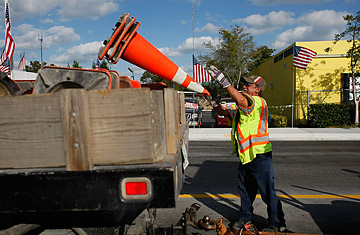
Guy Greenly picks up traffic cones at a road-construction site on Feb. 17 in Fort Lauderdale, Fla.
When Congress wrote the Build America Bond program into February's $787 billion economic-stimulus bill, many predicted a flop. Nine months later, the municipal-bond program, which provides a federal subsidy to help states and other local governments raise funds, looks to be one of the economic recovery effort's biggest successes. Earlier this month, the volume of BABs, as they have come to be called, crossed the $50 billion mark.
"People originally said it would eliminate the issuance of municipal bonds," says John Cummings, who is head of muni-bond investments at money-management firm PIMCO. "Instead they have stabilized the market and helped to create jobs."
Observers say Build America Bonds have lowered borrowing costs for states and other local governments. The bonds have renewed and expanded investor interest in the muni-bond sector. And by getting money into the hands of cash-strapped local governments, the bond program has saved or even boosted jobs, stimulating the economy. Many investors are already lobbying to extend the program, which is not expected to close until the end of 2010.
"It's the biggest thing to hit the municipal-bond market in a generation," says Amy Resnick, the editor in chief of The Bond Buyer, which tracks the muni market. "It's clearly been a success as a means of stimulating the economy."
But if Build America Bonds have proved popular, they may also end up being costly. Already, the volume of bonds issued means the federal government is committed to spending a billion dollars in the first year of the program alone. The final price tag may end up reaching $90 billion.
"For municipalities, it's been good, but it raises some political-economy questions," says Vincent Reinhart, a resident scholar at the conservative think tank American Enterprise Institute and a former top Federal Reserve economist. "This might encourage even more expansion of government borrowing."
A little over a year ago, the credit crisis caused the municipal-bond market to grind to a halt. Shell-shocked investors pulled back from even munis, which are normally considered a relatively safe bet. Bond yields soared. Local governments were forced to delay raising money. And auctions of short-term variable-rate muni securities failed.
Many credit BABs with reviving the muni-bond sector. Since the program was announced in mid-February, muni-bond interest rates, which are what local governments have to pay to borrow, have fallen dramatically. The typical municipality is now paying 3.7% when they issue a bond, down from as high as 4.5% in January, before the BABs program was announced, according to Barclays Capital. Some of the drop in yields reflects the improvement in the economy in general, and the easing of the credit crunch. But muni-bond-market observers say BABs have played an important role as well.
Under the program, the federal government subsidizes the bond payments that local governments make to investors, boosting the yield by 35%. So a typical muni bond that would normally pay 4.5% yields nearly 7% if it is issued through the Build America Bond program. The higher payments don't hurt the finances of the local government, because Uncle Sam is picking up the difference.
The higher yields of BABs have made muni bonds more attractive to pension funds and other nonprofit (i.e., tax-free) investors. And that new demand is driving down the yields on traditional muni bonds because there are relatively fewer of them issued. BABs, unlike traditional munis, are taxable. For most individual investors, the interest-rate difference is a wash — a high net worth investor would owe the extra yield they get from the BAB back in taxes, so they'd wind up with roughly the same after-tax yield as if they had bought a lower-yielding tax-free muni.
The only question about BABs is the cost. So far local governments have issued just over $50 billion in BABs with an average yield of just under 6%. That means the federal government is paying just over 2% interest on that debt a year, or about $1 billion. Many estimate that the volume of BABs could triple over the next year. What's more, most of these bonds are issued with a term of 15 or 30 years. That means by the end of 2010 the federal government could end up being on the hook for as much as $90 billion during the life of the bonds.
It's likely however the program won't cost nearly that much. First of all, some of the people buying BABs are individuals, who will owe taxes, though not all of them are in the highest tax bracket. What's more, BABs are bringing down the yields of all muni bonds, not just BABs. That is lowering the borrowing costs of local governments in general. That lower expense should save taxpayers money when it comes to paying their state and local taxes, even if it increases the money being shelled out by the federal government.
"Build America Bonds are a big subsidy that is costly to the federal government," says Michael Ettlinger, a vice president for economic policy at the liberal think tank Center for American Progress. "At some point we may say this is a subsidy we can't afford, but for now this is a great thing to do."
